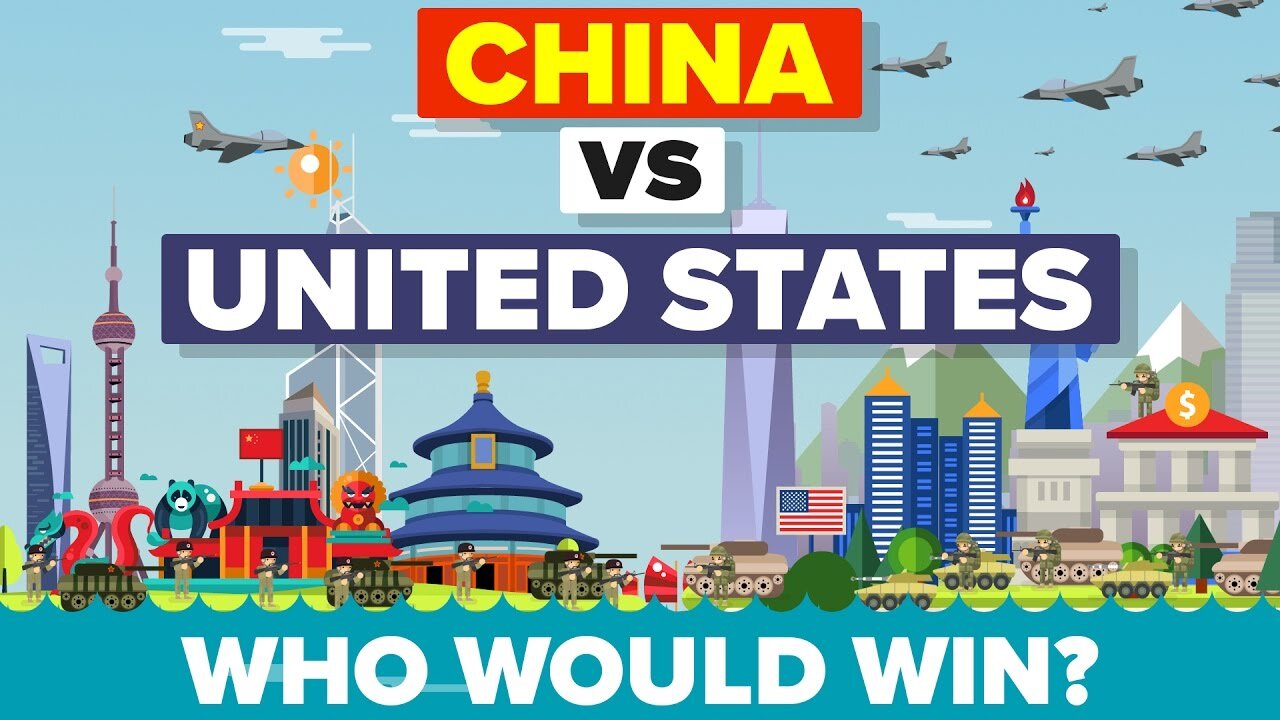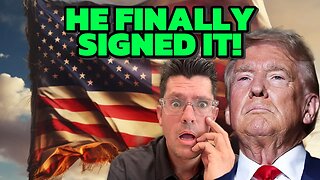Premium Only Content

World War Three Now Started China vs Taiwan and U.S.A. 7th Fleet Is Gone 44k Dead ?
The U.S. Naval Institute (USNI) and the Center for Strategic and International Studies (CSIS) hosted by Grand Vice Admiral New World Order U.S. Navy, Sub. Commander of In the year 2023 China and the United States are both world superpowers. They have similarly matched military, even though United States spends a lot more money. In this military comparison we are comparing China and USA, to see how they match up against each other and see who would win. Who do you think would win in a fight between China and the United States (air force, navy, nuclear, etc)? Which military is stronger and smarter? Seventh Fleet. Based in Yokosuka, Kanagawa Prefecture, Japan, the Seventh Fleet has 50 to 70 ships, 150 aircraft, and around 44,000 sailors and Marines and is part of the U.S. Pacific Fleet. Questions to the Vice Admiral were asked by the host and the online and in-person audience. Nuclear war - it's really happening.
For years kiwi lmmaker A.K. Strom belonged to a military news archive. And for years the realization grew that he had all the ingredients needed to produce the most frighteningly real build-up to nuclear war ever put on lm - and the most spectacular. The result is 'World War Four' - seven years in the making - the most chillingly realistic nuclear war movie you will ever see. This is a lm in which real armies march, bombs rain down, and soldiers storm the beaches. One family is caught up in the ever-growing con ict. Can they survive as total war is declared and nuclear weapons are unleashed?
What's the Taiwan-China conflict all about ? China views Taiwan as part of its territory and vows to "unify" the democratically-governed island with the mainland, using force if necessary. Tensions between the two sides are running high. Tensions between China and Taiwan have been rising in recent years driven by differences over the island's status.
Beijing claims sovereignty over the territory and has pledged to "unify" it with the mainland — by force if necessary.
Any military clash over Taiwan could also drag in the United States, given Washington's special ties to Taipei.
Here's a look at what the conflict is all about.
How did it start?
China and Taiwan have been separated since 1949, when the Chinese civil war ended with the victory of the Communists under the leadership of Mao Zedong. The defeated Nationalists, led by Mao's archrival and chief of the Kuomintang (KMT) party Chiang Kai-shek, retreated to Taiwan.
Taiwan, which has been governed independently since then, is officially known as the Republic of China while the mainland is called the People's Republic of China.
The island is separated from the mainland by the Taiwan Strait. It has a democratically elected government and is home to around 23 million people.
For over seven decades, Beijing has continued to view Taiwan as a Chinese province and vows to "unify" it with the mainland.
What is Taiwan's international status?
Beijing's stance is that there is only "one China" and that Taiwan is part of it.
China pressures countries worldwide to switch their allegiance to Beijing and cut diplomatic ties with Taiwan. At present, only 14 countries maintain official diplomatic relations with Taiwan.
Taipei is also not a member in agencies of the United Nations, although it holds membership of organizations like the Asian Development Bank and the World Trade Organization.
China also puts pressure on companies worldwide to list Taiwan as a part of China.
Governments and firms that do not toe Beijing's line on the issue risk backlash from the Chinese government.
In 2021, for instance, China cut off trade with EU member Lithuania for opening a Taiwanese representative office in its capital.
What's the US' relationship with Taiwan?
For almost three decades after the Communist government came to power in mainland China, the United States recognized Taipei as the government of all China.
But in 1979, Washington revoked its diplomatic ties and its mutual defense treaty with Taiwan and established formal diplomatic relations with mainland China.
Despite the shift, Washington has maintained close unofficial ties with Taipei.
It continues to sell military gear to Taiwan for self-defense, even though Beijing has repeatedly warned the US not to do so. US Navy warships also regularly sail through the Taiwan Strait to project American military power in the region.
The US says its goal is to ensure peace and stability in the Taiwan Strait. To this end, it wants to maintain the status quo.
Under President Donald Trump, the US deepened military ties with Taiwan and increased arms deliveries, selling over $18 billion worth of weapons to the island.
President Joe Biden has said the US would come to Taiwan's defense if China attacked. Could China go to war over Taiwan?
Beijing hasn't ruled out using force to pursue reunification of Taiwan with China.
In a major speech in January 2019, Chinese President Xi Jinping called for reunification and said that the status quo could not continue forever.
"We make no promise to renounce the use of force and reserve the option of taking all necessary means," he said at the time.
Xi has also stressed that the reunification is essential for the realization of the "Chinese dream" of restoring the country's great-power status in the world by 2049.
China is increasingly sending its fighters, bombers and surveillance aircraft near Taiwan, while also dispatching warships through the Taiwan Strait in a show of force.
The willingness to use force, coupled with China's rapidly expanding military capabilities and deteriorating cross-strait relations, has raised fears that it could trigger a conflict. What's the current state of cross-strait relations?
Cross-strait tensions have escalated since the election of Taiwanese President Tsai Ing-wen in 2016.
Under Tsai, the movement to formally declare independence has gained momentum in Taiwan.
The president's Democratic Progressive Party favors independence for the island.
Tsai disputed the existence of the 1992 consensus, a political agreement reached by representatives of Taipei and Beijing on the nature of their relationship. Both parties agreed that there was only "one China," although they had different views on what that meant.
Tsai and the DPP have also increased defense spending, with a record budget of nearly $17 billion (€16.7 billion) for 2022.
On Tuesday, Tsai boarded a naval warship for only the second time in her six years in office, where she lauded the military's determination to defend the island while overseeing its largest annual naval and air exercises.
The drills, which simulate the repulsion of an invading force, are part of efforts to boost combat preparedness in the face of rising military pressure from China.
When asked about the drills, Chinese Foreign Ministry spokesman Zhao Lijian repeated China's warnings about any military moves by Taiwan, Reuters reported.
"Taiwan's attempt to confront China militarily is akin to a mantis trying to obstruct a chariot," he said. "In the end, it is doomed to fail."
The year 2017 was among the worst in recent memory for the U.S. Navy.
A string of accidents in the Pacific, including two deadly collisions with commercial ships, left 17 sailors dead and a mountain of questions about how the Navy was using its Japan-based forces, and whether the service as a whole was overwhelmed by demands and responsibilities.
The accidents led to wholesale changes in leadership for the 7th Fleet based in the region, including a new commander, Vice Adm. Phil Sawyer, who was tasked with returning his fleet to a high state of readiness in the world’s most dangerous seas.
Sawyer has been in command since August 2017, and since then he’s led a shift in how 7th Fleet deploys its ships, a radical departure from the system in place prior to his arrival. In the past, ships relied on revolving certifications in their essential tasks, certifications that were lapsing routinely by 2017.
Defense News caught up with Sawyer, who was afloat on his command ship Blue Ridge in the East China Sea, to discuss the changes and what’s different about the 7th Fleet today.
The Navy made the decision to repair the destroyer John S. McCain in Japan rather than return it to the U.S. for refitting. It’s back in the water now. When will it go back on patrol?
I expect them to complete the [repairs] this spring. And then once they complete that, then they’ll go through sea trials and all the things we do when ships come out of deep maintenance like she’s gone through.
When we spoke last, you were implementing a plan known as “Optimized Fleet Response Plan—Japan” to institute a training cycle closer to the one U.S.-based ships go through to prepare for deployments. How’s that going?
When I talked to you last it was a two-year cycle and it was based on continuous certifications. That has since changed, and it is now a 36-month cycle, and that balances maintenance, training and operations, and it very closely resembles the models they use in the continental United States. We are in run with that new model, we haven’t had anyone complete the full 36-month cycle yet. But once they do complete it, it feeds into a maintenance period, and then they start the model over again.
You’ve gone from a model where ships, considered permanently deployed, must maintain their certifications based on periodicity. Now they earn certifications as they work up to deployments the way they do stateside. How is that adjustment going?
I’ll highlight two things: We have basic phase, advanced and integrated phases. All of those phases use the exact same standards used in the rest of the Navy. So I think when you talk to the guys out here on the waterfront, they recognize and appreciate the time given for training and certification. They know that it’s cordoned off and will know with predictability when they are going to be training, whether its basic or advanced. This gives the teams, the trainers, the families — everybody — the ability to plan.
So I think in general it’s producing a better force, and that’s key. But I think the sailors appreciate the predictability. One last area where Taiwan could do more to deter Beijing is in cyber warfare, or “electronic sabotage.” Using intelligence assets in China (closer contact between the two societies works both ways and doesn’t only create opportunities for China), Taiwan could identify and select civilian and military targets for retaliation, with the aim of severely disrupting China’s ability to operate normally should it launch an attack against the island. The banking and high-tech sectors would be likely targets. On the military side, promising to degrade, or perhaps even disable, China’s nuclear deterrent—even if momentarily— or knocking out its air defense systems, thus exposing China to USAF bombing runs, would be enough to make Beijing think twice about launching an invasion.
A consensus seems to have developed among a large number of defense analysts in recent years arguing that despite the balance of power having shifted in China’s favor, Beijing has no intention to use its military to invade Taiwan and thus resolve the Taiwan “question” once and for all. Doing so would be too costly, some argue, while others contend that Beijing can accomplish unification by creating enough economic dependence and incentives to convince Taiwanese over time of the “inevitability” of a “reunited” China.
Although these factors certainly militate against the desire to go to war over the island-nation, we cannot altogether discount the probability that the Chinese military would be called into action, especially if the rationale for launching an attack were framed in terms of a defensive war—China being “forced” to take action because of changing and “untenable” circumstances in its environment.
Therefore, despite the relatively low probability of war in the Taiwan Strait in the immediate future, Taipei cannot afford to be complacent and must actively pursue an effective defense strategy.
The first component of such a strategy is for Taipei to clearly define what the mission is, and just as importantly, what “victory” would look like. Given the quantitative and qualitative differences that exist between the two militaries, it is clear by now that victory for Taiwan can no longer be defined in maximalist terms: the total destruction of enemy forces.
Moreover, Taiwan does not have the means, nor does the intent, to take the fight to China to annihilate People’s Liberation Army (PLA) forces stationed on Chinese territory. Therefore, with a few—and important—exceptions that will be discussed below, the military area of operations in a war scenario would be the Taiwan Strait, and in a full invasion, the Taiwan side of the median line that divides the Strait.
Of course there are many different scenarios in which the PLA could be activated to pressure Taiwan, not all of them involving an all-out assault to invade the island. The PLA Navy (PLAN) and Air Force (PLAAF), for example, can be used to blockade Taiwan, while the Second Artillery Corps could be called upon to launch decapitation missile attacks against the Taiwanese leadership and other key targets across Taiwan, such as radar sites, airstrips, naval bases, and its C4ISR architecture.
In all those scenarios, Taiwan would be forced to adopt a purely defensive posture. The hardening and dispersal of targets, as well as improved air defense capabilities, are part of that strategy and what the Taiwanese military has prepared for over the years. The key in such “limited” scenarios will be to lower the chances that China would achieve its objectives.
Under current conditions, Taiwan arguably has sufficient resources and the right strategies in place to address those limited contingencies. If true, this would mean that those options are off the table for China, therefore forcing it to either abandon the idea that force can be used to coerce Taipei, or to escalate. The logic behind ensuring that Fortress Taiwan has the wherewithal to defend itself against limited attacks is that the more Beijing has to escalate, the greater the dilemma it faces as pressures—domestic and international—against such use of force, and therefore the potential costs of unleashing it, would be much more severe.
Still, there are contexts in which the dynamics that militate against full invasion would lose momentum. Chinese military literature is replete with references to defensive war and variations on that theme. Such language would be critical if it became necessary for the Beijing leadership to rationalize a decision to use total force to achieve its objectives. In such scenarios, China would position itself not as the aggressor, but rather as the victim, “forced” by external circumstances to go on the offensive, however begrudgingly, to protect its “vital” or “core” interests.
In other words, a change in context would leave the leadership with only two choices: capitulation or battle to defend the integrity of the Chinese territory. A declaration of de jure independence by Taiwan would certainly prompt such a response, with laws—the Anti-Secession Law—“forcing” Beijing to respond. China could also feel “compelled” to act if it deemed that political instability on the island were such that it threatened the safety of “Chinese compatriots”—in other words, Beijing could use its own “Crimea model” to justify massive use of force (humanitarian in this case) to occupy Taiwan.
It would therefore be incautious to rule out any possibility that China would use maximum force (short of the nuclear option) to attack Taiwan, to believe that rational calculations of costs versus benefits will prevail under any and all circumstances. Even if the probability is remote, it still exists. And given the trends within Taiwanese society which make unification with China less and less appealing, it is not entirely infeasible that a decade from now the Chinese leadership could decide it has to take military action—again for purely “defensive” purposes—lest “splittists” (of course aided by the CIA and other agencies bent on subjugating China) threaten to tear apart “one China” and inspire other groups within its territory to move in a similar direction.
So what could Taiwan do to ward off a PLA invasion? Since the Taiwanese military cannot hope to defeat the PLA in a conventional battlefield, and given that Taipei has no assurances that allies such as the United States and Japan would intervene on its side, its best defense is to ensure that China does not launch such an aggression in the first place. In other words, Taiwan must substantially increase the costs of invasion—real and perceived—by promising unacceptable amounts of pain to the PLA, the leadership in Beijing, and the Chinese population. Logically, this implies building up its capabilities to counter an amphibious assault through a combination of naval and aerial assets, as well as anti-armor rockets, missile batteries, artillery, mobile special forces units, and a well-trained and equipped reserve, to saturate the beaches with lead and create a kill zone for advancing PLA forces. Ensuring the survival of its air force and navy assets following saturation bombing by the Second Artillery in the initial phase of major hostilities would also be important, as those would also be necessary to counter PLA transport vessels ferrying troops across the Taiwan Strait.
However, such a passive, or “porcupine” defense strategy would probably not be enough to deter Beijing. Consequently, a second aspect of Taiwan’s plans to inflict unacceptable pain on China must explore more offensive options. It has already begun doing so, with the production and deployment of Land Attack Cruise Missiles (LACM), naval suppression kits, and standoff air-to-ground missiles (cluster bombs, anti-radiation) capable of disabling airfields as well as missile and radar sites in China. The deployment and dispersal of larger quantities of road-mobile or naval LACM launchers would also make it more difficult for the PLA to locate and destroy all of them and thus increase the potency of Taiwan’s counterstrike capabilities, especially if their range were increased (Taiwan should nevertheless keep the moral high ground by promising it would only use such assets against military targets). To maximize the impact of its counterforce capabilities, Taiwan would also have to improve its ability to pinpoint targets through greater investment in radar and satellite technology—and ensure redundancy, as those would also likely be targeted by the PLA in the initial phase of a conflict. Greater human intelligence assets inside China, as well as the ability to conduct sabotage against key military (and economic) sites, would complement the offensive aspect of Taiwan’s defense strategy. Other options include armed unmanned aerial vehicles (UAV) and a larger fleet of submarines with conventional LACM capability. All of this is contingent on a political decision to invest more on defense than Taiwan does at present.
Beyond kinetic strategies, several asymmetrical options are also available to Taiwan to maximize the pain of a PLA invasion, with the ultimate goal of deterring such action. On the political side, Taipei should redouble its efforts in political warfare. The first aim of this strategy should be to counter similar operations by China, which have succeeded in undermining morale in the Taiwanese military while encouraging the perception abroad that Taiwan is an unreliable security partner, or that unification is inevitable or even desirable.
On October 16, 1964, the People’s Republic of China became the fifth nation to possess an atomic bomb, joining the United States, the Soviet Union and other nations.0 Although no atomic bombs were ever used against China by the United States, President Dwight D. Eisenhower made similar threats after Mao offered Chinese support to the Viet Cong in French Indochina. On June 17th 1967 China detonated its first hydrogen bomb and its effects are largely unexplored due to lack of publicly available official data.
The People’s Republic of China joins the rank of nations with atomic bomb capability, after a successful nuclear test on October 16, 1964. China is the fifth member of this exclusive club, joining the United States, the Soviet Union, Great Britain and France.
U.S. officials were not terribly surprised by the test; intelligence reports since the 1950s indicated that China was working to develop an atomic bomb, possibly aided by Soviet technicians and scientists. Nevertheless, the successful test did cause concern in the U.S. government. During the early 1960s, China took a particularly radical stance that advocated worldwide revolution against the forces of capitalism, working strenuously to extend its influence in Asia and the new nations of Africa. The test, coming just two months after the Tonkin Gulf Resolution (a congressional resolution giving President Lyndon B. Johnson the power to respond to communist aggression in Vietnam) created a frightening specter of nuclear confrontation and conflict in Southeast Asia.
The test also concerned the Soviet Union; the split between the USSR and communist China over ideological and strategic issues had widened considerably by 1964. The Chinese acquisition of nuclear capabilities only heightened the tensions between the two nations. Indeed, the test might have been a spur to the Soviets to pursue greater efforts to stop the proliferation of nuclear weapons; in 1968, the United States and the Soviet Union signed the Treaty on the Non-Proliferation of Nuclear Weapons. Little wonder that the Soviets would wish to see China’s nuclear force limited, since the first Chinese intermediate-range missiles were pointedly aimed at Russia. The Cold War nuclear arms race had just become a good deal more complicated.
Chinese bombers simulated an attack on a US Navy aircraft carrier in the South China Sea A US Navy carrier strike group sailed into the South China Sea last Saturday.
The same day, a large force of Chinese military aircraft, including fighters and bombers, flew past Taiwan and into the waterway.
The Chinese aircraft conducted a simulated attack on the US carrier, a US defense official told Insider Friday, confirming earlier reporting from The Financial Times.
Visit Business Insider's homepage for more stories. Chinese bombers recently simulated an attack on a US Navy aircraft carrier in the South China Sea, a US defense official said Friday, confirming earlier reporting from the Financial Times.
As the Navy's Theodore Roosevelt carrier strike group sailed into the South China Sea this past Saturday, the Chinese military sent eight H-6K bombers, four J-16 fighter jets, and one Y-8 anti-submarine warfare aircraft flying past Taiwan and into the contested waterway.
Tracking data indicates the US carrier strike group entered the South China Sea by way of the Bashi Channel as the Chinese fighters flew through Taiwan's air defense identification zone.
The next day, an unidentified mainland military analyst told China's state-affiliated Global Times that the Chinese move may have been a training exercise intended to "boost the PLA's combat capability against US aircraft carriers," as the bombers could practice launching a saturation attack against the US ships.
Another analyst told the paper that the flights were "likely routine operations" that had nothing to do with the US vessels nearby. The Financial Times, citing persons familiar with the US and allied intelligence, reported Friday that the Chinese bombers and fighters simulated an attack on the Theodore Roosevelt carrier strike group. The Chinese bomber pilots were also reportedly overheard confirming naval strike orders and simulating the firing of anti-ship missiles.
US Indo-Pacific Command spokesperson Capt. Mike Kafka told Insider in an emailed statement that "the Theodore Roosevelt Carrier Strike Group closely monitored all People's Liberation Army Navy (PLAN) and Air Force (PLAAF) activity, and at no time did they pose a threat to US Navy ships, aircraft, or Sailors."
A defense official said that the Chinese aircraft did not come within 250 nautical miles of the US Navy vessels, putting them well outside the maximum estimated range of the YJ-12 anti-ship cruise missiles the H-6K bombers can carry. There was a simulated attack run though, the official said.
Sources told Reuters the Chinese bombers were simulating a combat operation against a US flattop, with one saying that "they purposely conducted the drills when the US carrier was passing through the Bashi Channel."
Kafka said in the INDOPACOM statement, "the PLA activities highlighted here, are the latest in a string of aggressive and destabilizing actions."
The spokesman said that "these actions reflect a continued PLA attempt to use its military as a tool to intimidate or coerce those operating in international waters and airspace, to include their neighbors and those with competing territorial claims," adding that the "United States will continue to fly, sail and operate wherever international law allows, demonstrating resolve through our operational presence throughout the region."
The US Navy said in a statement last Sunday that the Theodore Roosevelt carrier strike group is on a routine deployment to the US 7th Fleet area of responsibility to conduct maritime security operations.
China objects to the regular presence of the US military in the South China Sea, even though it has operated in the area for decades.
"It does no good to regional peace and stability for the United States to frequently send military vessels and aircraft to the South China Sea to show off its muscles," Chinese Ministry of Foreign Affairs spokesman Zhao Lijian said during a press briefing Monday.
The latest developments in the South China Sea highlight the challenges the new Biden administration will face as it deals with Beijing and China's growing military power.
The new administration and China have already traded jabs over Taiwan. During Monday's press briefing, Zhao told the US to "refrain from sending any wrong signals to the 'Taiwan independence' forces so as to avoid damaging China-US relations and peace and stability across the Taiwan Strait" after the US State Department criticized China's efforts to militarily, economically, and diplomatically pressure Taiwan.
Chinese Ministry of Defense spokesman Wu Qian said Thursday that Chinese military activities near Taiwan are necessary and warned that it would mean war if Taiwan pursued independence from China.
Speaking at the first Department of Defense press briefing of the Biden administration, Pentagon spokesman John Kirby reaffirmed US support for Taiwan's defense but said that tensions "need not lead to anything like confrontation."
Military planners in Washington pushed for the White House to prepare plans to use nuclear weapons against mainland China during the Taiwan Strait crisis in 1958, newly leaked documents appear to confirm.
The documents, first reported on by the New York Times Saturday, reveal the extent of Washington’s discussions about using nuclear weapons to deter a Chinese invasion of Taiwan, including the acceptance by some US military leaders of possible retaliatory nuclear strikes on US bases.
The new information was provided to the Times by Daniel Ellsberg, the whistleblower who in 1971 leaked the Pentagon Papers that detailed the US government’s duplicity in its handling of the Vietnam War.
“US first use of nuclear weapons should not be contemplated, prepared, or threatened anywhere, under any circumstances, including the defense of Taiwan,” Ellsberg said in a post to his Twitter on Sunday.
The Taiwan leak comes from previously classified sections of a 1966 report by think tank Rand Corporation on the 1958 Taiwan Straits crisis, written by M. H. Halperin for the Office of the then-Assistant Secretary of Defense.
After the Communist Party took power in mainland China in 1949, following a brutal civil war, the Nationalist government fled to Taiwan. But Beijing viewed the island as part of its territory, and the two sides clashed intermittently over the following decades.
The closest the US and China came to armed conflict was during the Taiwan Strait crisis in 1958, when the People’s Republic of China fired artillery at Taipei’s outlying islands. Washington worried the shelling could be a precursor to a full invasion. The shelling focused on the Quemoy and Matsu island groups, which lie between Taiwan and mainland China and are described by Rand Corporation as “the first line of defense” for Taipei.
Although it is already public knowledge that the Eisenhower administration debated whether to use nuclear weapons to deter China from attacking Taiwan, the documents appear to reveal the extent of the planning for the first time.
According to the leaked documents, some US Defense and State department officials were concerned the loss of the outlying islands in 1958 could lead to a full “Chinese Communist takeover of Taiwan.”
In the event of an air and sea attack on the islands, US Air Force Gen. Nathan Twining said the US would have to use nuclear weapons against Chinese air force bases “to prevent a successful air interdiction campaign,” beginning with “low-yield ten to fifteen kiloton nuclear weapons.”
If this didn’t lead to a break in the assault from mainland China, “the United States … would have no alternative but to conduct nuclear strikes deep into China as far north as Shanghai.”
According to the documents, the Chairman of the Joint Chiefs acknowledged this would “almost certainly” lead to nuclear retaliation against Taiwan and the US military base at Okinawa in Japan. “But he stressed that if national policy is to defend the offshore islands then the consequences had to be accepted,” the document said.
Given China had yet to develop its own nuclear capabilities, any nuclear retaliation would have come from the Soviet Union, possibly sparking an even more devastating global conflict. The report said it isn’t clear where the nuclear retaliation would have originated.
The document said the US Joint Chiefs, and Twining in particular, saw the use of atomic weapons as “inevitable.” In one section, Gen. Laurence S. Kuter, the top Air Force commander for the Pacific, “flatly” states that any US air action against a Chinese attack on the outlying islands “had no chance of success unless atomic weapons were used from the outset.”
In the end, Eisenhower was hesitant to use nuclear weapons and pushed for the US troops to stick to conventional arms. Joshua Pollack, editor of the Nonproliferation Review, said on Twitter Sunday that the idea the US would have risked a nuclear exchange with the Soviet Union over islands with “no military value” was “jarring.”
“It’s no surprise the White House said no,” he said.
A ceasefire was reached in the Taiwan Strait on October 6, 1958, although there have been ongoing tensions between Beijing and Taipei.
In January 2019 speech, Chinese President Xi Jinping warned he would take “all means necessary” and not “renounce the use of force” to rejoin Taiwan to the Chinese mainland.
Beijing claims full sovereignty over Taiwan, a democracy of almost 24 million people located off the southeastern coast of mainland China, even though the two sides have been governed separately for more than seven decades.
With military tensions rising again between the US and China, whistleblower Ellsberg said in his interview with the Times that he had supplied the documents due to his concerns over the possibility of a new war over Taiwan.
That time the US dropped an atomic bomb on a fleet of 95 ships In 1946, French fashion designer Jacques Heim released a woman’s swimsuit he called the “Atome” (French for “atom”) – a name selected to suggest its design would be as shocking to people that summer as the atomic bombings of Japan had been the summer before.
Not to be outdone, competitor Louis Réard raised the stakes, quickly releasing an even more skimpy swimsuit. The Vatican found Réard’s swimsuit more than shocking, declaring it to actually be “sinful.”
So what did Réard consider an appropriate name for his creation? He called it the “Bikini” – a name meant to shock people even more than “Atome.”
But why was this name so shocking?
In the summer of 1946, “Bikini” was all over the news. It’s the name of a small atoll – a circular group of coral islands – within the remote mid-Pacific island chain called the Marshall Islands. The United States had assumed control of the former Japanese territory after the end of World War II, just a few months earlier.
The United States soon came up with some very big plans for the little atoll of Bikini.
After forcing the 167 residents to relocate to another atoll, they started to prepare Bikini as an atomic bomb test site. Two test bombings scheduled for that summer were intended to be very visible demonstrations of the United States’ newly acquired nuclear might.
Media coverage of the happenings at Bikini was extensive, and public interest ran very high. Who could have foreseen that even now – 70 years later – the Marshall Islanders would still be suffering the aftershocks from the nuclear bomb testing on Bikini Atoll?
The big plan for tiny Bikini
According to the testing schedule, the U.S. plan was to demolish a 95-vessel fleet of obsolete warships on June 30, 1946 with an airdropped atomic bomb. Reporters, U.S. politicians, and representatives from the major governments of the world would witness events from distant observation ships.
On July 24, a second bomb, this time detonated underwater, would destroy any surviving naval vessels.
These two sequential tests were intended to allow comparison of air-detonated versus underwater-detonated atomic bombs in terms of destructive power to warships. The very future of naval warfare in the advent of the atomic bomb was in the balance.
Many assumed the tests would clearly show that naval ships were now obsolete, and that air forces represented the future of global warfare.
But when June 30 arrived, the airdrop bombing didn’t go as planned. The bomber missed his target by more than a third of a mile, so the bomb caused much less ship damage than anticipated.
The subsequent underwater bomb detonation didn’t go so well either.
It unexpectedly produced a spray of highly radioactive water that extensively contaminated everything it landed on. Naval inspectors couldn’t even return to the area to assess ship damage because of the threat of deadly radiation doses from the bomb’s “fallout” – the radioactivity produced by the explosion.
All future bomb testing was canceled until the military could evaluate what had gone wrong and come up with another testing strategy.
And even more bombings to follow
The United States did not, however, abandon little Bikini. It had even bigger plans with bigger bombs in mind. Ultimately, there would be 23 Bikini test bombings, spread over 12 years, comparing different bomb sizes, before the United States finally moved nuclear bomb testing to other locations, leaving Bikini to recover as best it could.
The most dramatic change in the testing at Bikini occurred in 1954, when the bomb designs switched from fission to fusion mechanisms.
Fission bombs – the type dropped on Japan – explode when heavy elements like uranium split apart. Fusion bombs, in contrast, explode when light atoms like deuterium join together.
Fusion bombs, often called “hydrogen” or “thermonuclear” bombs, can produce much larger explosions.
The United States military learned about the power of fusion energy the hard way, when they first tested a fusion bomb on Bikini. Based on the expected size of the explosion, a swath of the Pacific Ocean the size of Wisconsin was blockaded to protect ships from entering the fallout zone.
On March 1, 1954, the bomb detonated just as planned – but still there were a couple of problems.
The bomb turned out to be 1,100 times larger than the Hiroshima bomb, rather than the expected 450 times. And the prevailing westerly winds turned out to be stronger than meteorologists had predicted.
The result? Widespread fallout contamination to islands hundreds of miles downwind from the test site and, consequently, high radiation exposures to the Marshall Islanders who lived on them.
Dealing with the fallout, for decades
Three days after the detonation of the bomb, radioactive dust had settled on the ground of downwind islands to depths up to half an inch.
Natives from badly contaminated islands were evacuated to Kwajalein – an upwind, uncontaminated atoll that was home to a large U.S. military base – where their health status was assessed.
Residents of the Rongelap Atoll – Bikini’s downwind neighbor – received particularly high radiation doses. They had burns on their skin and depressed blood counts.
Islanders from other atolls did not receive doses high enough to induce such symptoms. However, as I explain in my book “Strange Glow: The Story of Radiation,” even those who didn’t have any radiation sickness at the time received doses high enough to put them at increased cancer risk, particularly for thyroid cancers and leukemia.
What happened to the Marshall Islanders next is a sad story of their constant relocation from island to island, trying to avoid the radioactivity that lingered for decades.
Over the years following the testing, the Marshall Islanders living on the fallout-contaminated islands ended up breathing, absorbing, drinking and eating considerable amounts of radioactivity.
In the 1960s, cancers started to appear among the islanders.
For almost 50 years, the United States government studied their health and provided medical care. But the government study ended in 1998, and the islanders were then expected to find their own medical care and submit their radiation-related health bills to a Nuclear Claims Tribunal, in order to collect compensation.
Marshall Islanders still waiting for justice
By 2009, the Nuclear Claims Tribunal, funded by Congress and overseen by Marshall Islands judges to pay compensation for radiation-related health and property claims, exhausted its allocated funds with $45.8 million in personal injury claims still owed the victims.
At present, about half of the valid claimants have died waiting for their compensation.
Congress shows no inclination to replenish the empty fund, so it’s unlikely the remaining survivors will ever see their money.
But if the Marshall Islanders cannot get financial compensation, perhaps they can still win a moral victory. They hope to force the United States and eight other nuclear weapons states into keeping another broken promise, this one made via the Treaty on the Non-Proliferation of Nuclear Weapons.
This international agreement between 191 sovereign nations entered into force in 1970 and was renewed indefinitely in 1995. It aims to prevent the spread of nuclear weapons and work toward disarmament.
In 2014, the Marshall Islands claimed that the nine nuclear-armed nations – China, Britain, France, India, Israel, North Korea, Pakistan, Russia and the United States – have not fulfilled their treaty obligations.
The Marshall Islanders are seeking legal action in the United Nations International Court of Justice in The Hague. They’ve asked the court to require these countries to take substantive action toward nuclear disarmament.
Despite the fact that India, North Korea, Israel and Pakistan are not among the 191 nations that are signatories of the treaty, the Marshall Islands’ suit still contends that these four nations “have the obligation under customary international law to pursue [disarmament] negotiations in good faith.”
The process is currently stalled due to jurisdictional squabbling. Regardless, experts in international law say the prospects for success through this David versus Goliath approach are slim.
But even if they don’t win in the courtroom, the Marshall Islands might shame these nations in the court of public opinion and draw new attention to the dire human consequences of nuclear weapons.
That in itself can be counted as a small victory, for a people who have seldom been on the winning side of anything. Time will tell how this all turns out, but more than 70 years since the first bomb test, the Marshall Islanders are well accustomed to waiting.
-
 28:27
28:27
What If Everything You Were Taught Was A Lie?
3 days agoWater Holds The Memory Of Creation And What Is Consciousness And Firmament Of God Is Water ?
1.44K -
 LIVE
LIVE
TimcastIRL
1 hour agoTrump Orders Specialized National Guard Units To Combat Crime In Cities, Dems Furious | Timcast IRL
22,908 watching -
 LIVE
LIVE
SpartakusLIVE
2 hours ago#1 Rocket CHAMPION of Verdansk wields UNSTOPPABLE new META
278 watching -
 LIVE
LIVE
Barry Cunningham
2 hours agoPRESIDENT TRUMP MADE TODAY A VERY BAD DAY TO BE A DEMOCRAT!
6,672 watching -
 1:45:02
1:45:02
Glenn Greenwald
3 hours agoIsrael Slaughters More Journalists, Hiding War Crimes; Trump's Unconstitutional Flag Burning Ban; Glenn Takes Your Questions | SYSTEM UPDATE #504
68K46 -
 LIVE
LIVE
Stephen Gardner
38 minutes ago🔥'Burn ALL TRUMP FLAGS’ says Tim Walz + Democrat CAUGHT rigging own election!
496 watching -
 10:10
10:10
robbijan
1 day agoHollywood’s Hidden Messages: Predictive Programming & What’s Next
1.13K2 -
 40:13
40:13
MattMorseTV
2 hours ago🔴It's EVEN WORSE than we thought...🔴
12K34 -
 LIVE
LIVE
The Jimmy Dore Show
3 hours agoSnoop Dogg Is DONE w/ LBGTQ+ Propaganda In Kids Movies! Trump Outlaws Burning the U.S. Flag!
7,296 watching -
 LIVE
LIVE
MissesMaam
4 hours agoDying Light w/ Da Bois💚✨
124 watching